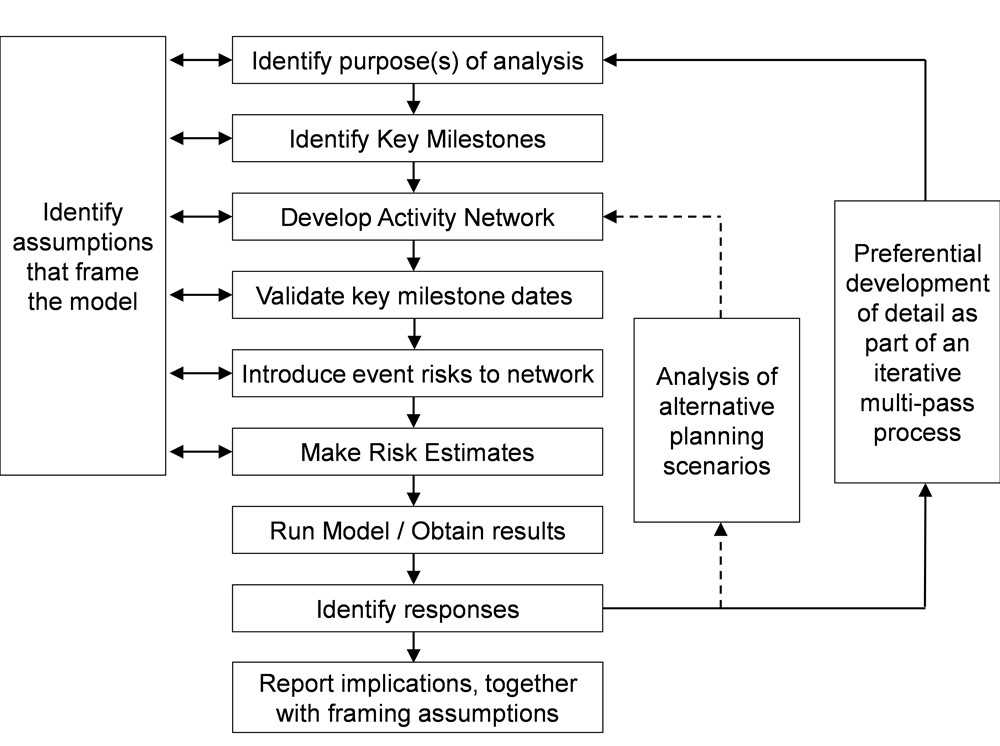A brief guide
Practical Project Risk Management
SERIES ARTICLE
By Martin Hopkinson
United Kingdom
Purpose
Provide a step by step process to develop schedule risk models of good quality. This guidance should be read in conjunction with the Schedule Risk Analysis guidance sheet (May, 2023)
A Recommended Process

Notes
Typical purposes of analysis are listed in the Schedule Risk Analysis guidance sheet (May, 2023)
A good starting point is to identify between four and ten key milestones. Ideally, these will be spread reasonably evenly over time, be known to be the type of milestone vulnerable to schedule slippage, mark points at which high risk activity paths converge and be of interest to key decision makers and stakeholders.
An initial simple version of the activity network can be built using the key milestones as a framework. Further detail can then be added by including more activities and dependencies where justified by the purposes of the analysis. Care should be taken to avoid modelling low levels of detail that are liable to change as events unfold during the project.
The activity network can be validated by comparing it to the deterministic version of the project schedule (which will typically be broken down into much more detail). Key milestones dates should align. The validation approach should also include a Modelling quality checklist.
More…
To read entire article, click here
Editor’s note: This series of articles is by Martin Hopkinson, author of the books “The Project Risk Maturity Model” and “Net Present Value and Risk Modelling for Projects” and contributing author for Association for Project Management (APM) guides such as Directing Change and Sponsoring Change. These articles are based on a set of short risk management guides previously available on his company website, now retired. For an Introduction and context for this series, click here. Learn more about Martin Hopkinson in his author profile below.
How to cite this paper: Hopkinson, M. (2023). A Process for Developing Schedule Risk Models: A brief guide, Practical Project Risk Management series, PM World Journal, Vol. XII Issue VII, July. Available online at https://pmworldlibrary.net/wp-content/uploads/2023/07/pmwj131-Jul2023-Hopkinson-schedule-risk-model-development-article.pdf
About the Author

Martin Hopkinson
United Kingdom
![]()
Martin Hopkinson, recently retired as the Director of Risk Management Capability Limited in the UK, and has 30 years’ experience as a project manager and project risk management consultant. His experience has been gained across a wide variety of industries and engineering disciplines and includes multibillion-pound projects and programmes. He was the lead author on Tools and Techniques for the Association for Project Management’s (APM) guide to risk management (The PRAM Guide) and led the group that produced the APM guide Prioritising Project Risks.
Martin’s first book, The Project Risk Maturity Model, concerns the risk management process. His contributions to Association for Project Management (APM) guides such as Directing Change and Sponsoring Change reflect his belief in the importance of project governance and business case development.
In his second book Net Present Value and Risk Modelling for Projects he brought these subjects together by showing how NPV and risk modelling techniques can be used to optimise projects and support project approval decisions. (To learn more about the book, click here.)
To view other works by Martin Hopkinson, visit his author showcase in the PM World Library at https://pmworldlibrary.net/authors/martin-hopkinson/









